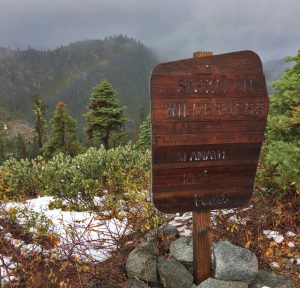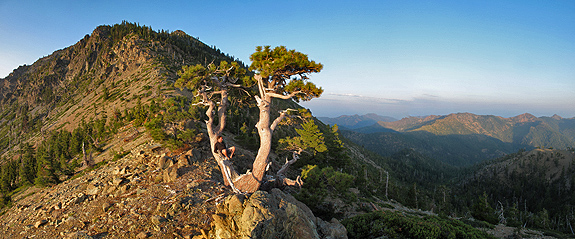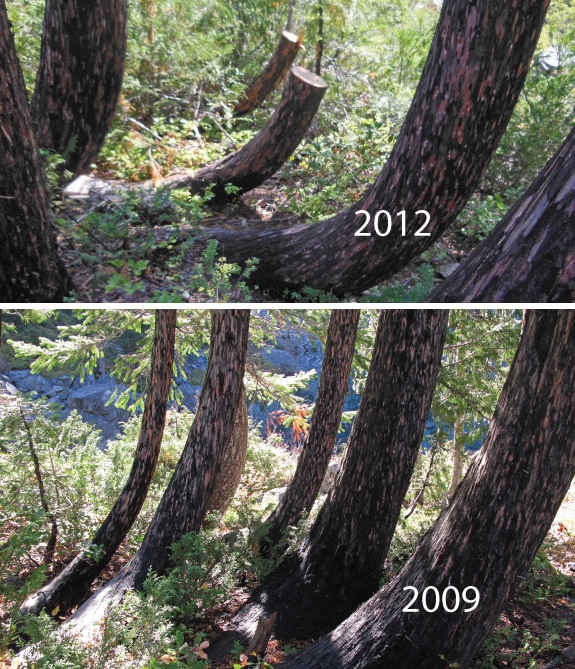BLURB FROM THE TALK: Humboldt County educator, author, and ecologist Michael Kauffmann has been tracking the status and distribution of Klamath Mountain conifers for over 15 years and his book, Conifer Country, if the definitive field guide to the region. Michael will take us from mountain summits to coastal river valleys and provide updates on the status and distribution of many of these charismatic conifers based on field work in the summer of 2019 with the California Native Plant Society Vegetation Team. He will also share photos and stories about exciting plants from the region.
Bear Peak Botanical Area
Citizen Science in the Siskiyous
 I recently started a citizen science project with 5 classes of high school biology students from Fortuna, California. The plan is to combine their observation skills with the technology offered by iNaturalist. Each month they will visit Rohner Park and record data on a chosen spot in the forest–looking for plants and animals as well as changes in canopy and ground cover. As they become more proficient in species ID, students will also upload observations to our iNatural Project ultimately creating a field guide to their local forest. We all know how much I like field guides…
I recently started a citizen science project with 5 classes of high school biology students from Fortuna, California. The plan is to combine their observation skills with the technology offered by iNaturalist. Each month they will visit Rohner Park and record data on a chosen spot in the forest–looking for plants and animals as well as changes in canopy and ground cover. As they become more proficient in species ID, students will also upload observations to our iNatural Project ultimately creating a field guide to their local forest. We all know how much I like field guides…
My plan, over future visits to wilderness areas, is to start similar citizen science projects. The first attempt at this wide-ranging project began this week on a visit to the Bear Peak Botanical Area on the Klamath National Forest. I originally wrote about this area in my book Conifer Country because it is unique in many ways, including the populations of yellow-cedar found here. This species in common further north, but quite rare in California.
My Side of a Mountain
Original Publication DATE: 8/3/2012

The northern portion of the Siskiyou Wilderness represents an area of great botanical diversity resulting from its unique geographic position (proximity to the coast and extreme vertical relief) and complex and diverse geologic composition. Chester A. Ground (1972) identified 343 species of plants in 3 square miles around the mountain my college buddies and I decided to climb in late July 2012. Just like my childhood fictional hero Sam Gribley, we escaped to a place near and dear to my heart, and–though not for an entire winter–for enough time to share space and time with the unique and diverse biota of the Klamath Mountans. We were in for a treat as the weather was cool and clear, plants were in bloom, and wildlife was active.
The Cry of the Wilderness (and C. nootkatensis)
Original Publication DATE: 10/27/2012
“Wilderness has a deceptive concreteness at first glance. The difficulty is that while the word is a noun it acts like an adjective. There is no specific material object that is wilderness. The term designates a quality ( as the ‘-ness’ suggests) that produces a certain mood or feeling in a given individual and, as a consequence, may be assigned by that person to specific place. Because of this subjectivity a universally acceptable definition of wilderness is elusive. One man’s wilderness may be another’s roadside picnic… Wilderness, in short, is so heavily freighted with meaning of a personal, symbolic, and changing kind as to resist easy definition.”
—Wilderness and the American Mind, Roderick Nash, third edition; pub. Yale Univ. Press, 1967.
Siskiyou Wilderness | fall 2012
My expectations for wilderness wavers too. As I sit at home with my creature comforts I hope that others are out enjoying the majesty of the wilds–connecting with the natural world and progressing as stewards. When my turn comes to plan a wilderness adventure, destinations are chosen based on where I will find solitude. This was the original, anthropocentric idea behind wilderness–a place that would retain primeval character and guarantee solitude. I am a proponent for more people visiting wilderness (walking in under their own power) so that they might have more authentic experiences in nature, care more, and develop a closer connection to the Earth.
Continue reading “The Cry of the Wilderness (and C. nootkatensis)”High Pressure in the Siskiyou Wilderness
Original Publication DATE: 12/16/2011
